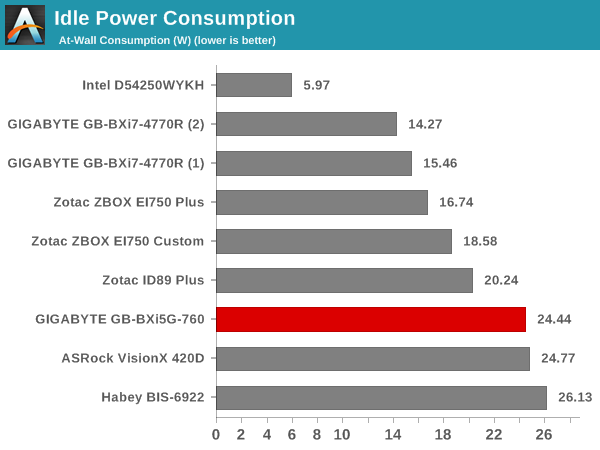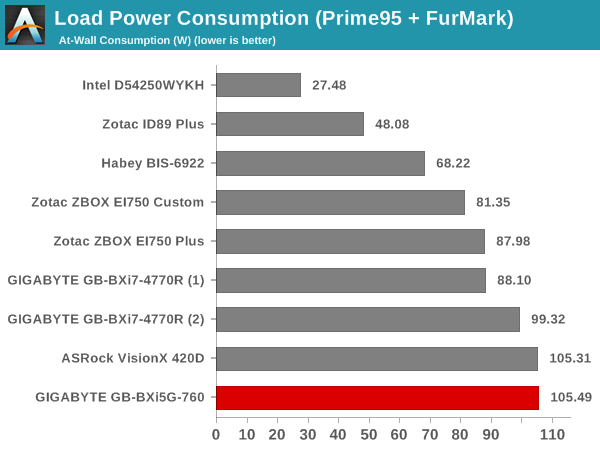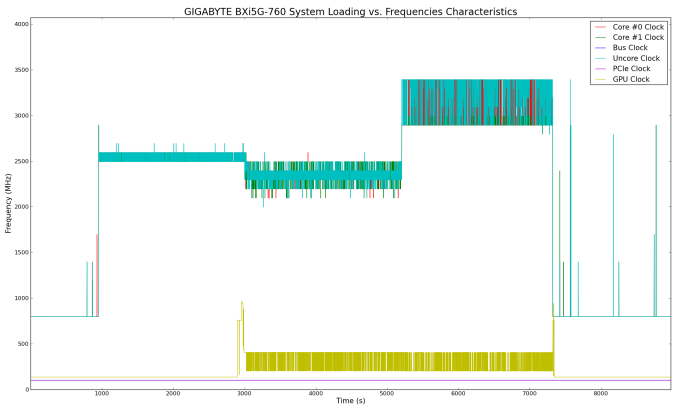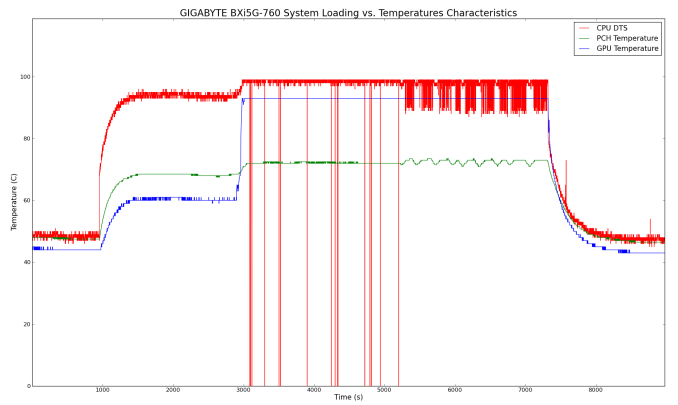GIGABYTE BRIX Gaming BXi5G-760 mini-PC Review
by Ganesh T S on September 15, 2014 2:30 PM ESTMiscellaneous Aspects & Final Words
The power consumption at the wall was measured with the display being driven through one of the mini-HDMI ports. In the graphs below, we compare the idle and load power of the BXi5G-760 with other low power PCs evaluated before. For load power consumption, we ran Furmark 1.12.0 and Prime95 v27.9 together. The BXi5G-760 is not the most power efficient PC around, but the target market (gamers) don't need to care too much. The numbers are not beyond the realm of reason for the combination of hardware components in the machine.


Even though the steady state power consumption in the simultaneous CPU and GPU loading case was around 105 W, we did see an initial spike into the 150 W range before stabilization.
Thermal Performance
Given the size of the chassis, throttling under heavy load was always a possibility. Our fears turned out to be true, as the two graphs below show. The various clocks in the system as well as the temperatures with the unit are presented below. For the first 15 minutes, we have the unit at idle. This was followed by 30 minutes of pure CPU loading, followed by another 30 minutes of both CPU and GPU being loaded simultaneously. We found throttling in effect at that point. After this, the CPU load was removed, allowing the GPU to be loaded alone for another 30 minutes.
In the graphs on either side, we find that the idle clocks are around 800 MHz for the CPU cores and around 135 MHz for the GPU, with the temperatures between 40 and 50 C inside the unit. With the plain CPU loading for 30 minutes, we find there is no throttling and the CPU temperatures stabilising around 94 C with the core clocks around 2.5 GHz. Once the GPU kicks into gear, we can see the red dips in the temperature graph below. Since we are graphing DTS here, a value of 0 means that the system needs to throttle to bring temperatures back in the operating range. The core clocks go down ro around 2.1 - 2.3 GHz. Note that the GPU clocks were only very briefly at the advertised 941 MHz. Eventually, under sustained loading, they end up oscillating between 202.5 MHz and 405 MHz. When the Prime 95 loading is taken off, the CPU has more headroom and ramps up to 3.4 GHz frequently to help keep the GPU loaded. An advantage with the active thermal solution is that the temperatures return to idling points very quickly after removal of the load.
The safe temperature limit for the GTX 760 has been set at 97 C, and we found that the solution in the BX i5G-760 levelled out around 93 C under these loading conditions. The GPU does fine-grained management of the clock frequency (which is interpreted by Furmark as throttling) to manage the thermals.
Concluding Remarks
GIGABYTE has managed to cram impressive gaming components into a small chassis. If there were a metric for gaming performance per cubic-foot, the BXi5G-760 would win it hands down. The NVIDIA GTX 760 / GTX 870M is also a top notch choice for gaming in this form factor. Its HTPC credentials are also excellent. The pre-integration of the WLAN component (Realtek-based 1x1 802.11ac) makes things very simple for the end user to complete the build. The triple-display output is a welcome feature for gamers.
On the pricing side, the BXi5G-760 comes in at $800 without the DRAM or a boot drive. That is steep for a machine with limited expansion possibilities. GIGABYTE has also tied up with 'Unified Remote' to provide control of the PC using mobile devices. It would have been nice on GIGABYTE's part to supply a few codes for the full version of the Unified Remote mobile app. That said, this is a nice alternative to the MCE remotes that other vendors are supplying with their mini-PCs.
In conclusion, if one is looking for a highly portable non-DIY gaming mini-PC, it is hard to go wrong with the GIGABYTE BXi5G-760.













35 Comments
View All Comments
kgh00007 - Monday, September 15, 2014 - link
Nice review, I hope you guys get in the Alienware Alpha for review. I think that's going to make a really nice HTPC depending on what GPU is announced for it!WatcherCK - Monday, September 15, 2014 - link
Or as another possibility for a heating solution would be to hack on an external radiator ala R295x2, you will loose some of the convenience of the form factor with the addition of an external cooler but given the thermal load of the components it would be more than adequate for cooling this wee box :)SuperVeloce - Monday, September 15, 2014 - link
6GB gddr5 ? are they for real?hojnikb - Tuesday, September 16, 2014 - link
They are probobly targeting novice users that dont know better.And 6GB of graphics memory sound real nice.
TheinsanegamerN - Monday, September 15, 2014 - link
With the heat and throttling problems this BRIX has, how long until it BRIX itself (ba dum tiss).Seriously though, why not use a slightly bigger enclosure along with a geforce 860m? that would have been cheaper, cooler, and quieter.
Laststop311 - Tuesday, September 16, 2014 - link
Rather build a micro atx tower with a MSI gaming twin frozr cooler GTX 770 and i5-4690k tower 70 + psu 60 + 150 mobo + 100 ram + gtx 770 320 + i5-4690k 250 + 120GB crucial m500 70 + Noctua u14s heatsink +75 + 3x noctua fans to replace case fans 60 = 1135 so for the measly sum of 160 extra dollars you can build a MUCH more powerful PC that is much quieter. The msi gpu is one of the quietest twin frozr is excellent the u14s noctua heatsink is actually quieter than water cooling and even surpasses the 120mm close loops and is about equal to the 240mm closed loops in performance. Since all the case fans are noctua and there is no hard drive the only noise you are going to hear is power supply noise and gpu noise and the power supply fan only kicks on when under heavy load, Such performance such silence. Sure the size is bigger but a micro atx tower isn't THAT bad and I'm not hurting for space.Laststop311 - Tuesday, September 16, 2014 - link
1155 it equals forgot to update that valueBob Todd - Tuesday, September 16, 2014 - link
1) In general I agree. I'd just build something much more powerful that was larger.2) Tiny builds have always had a significantly worse power/price ratio, so the "I'd just build X that is Y times the size" could be a template response to any of these SFF machines.
There is at least some back of the napkin math that shows these companies that there is enough of a market for these types of machines at these types of price points that they will be beneficial to their bottom line. Personally I think a cheap NUC form factor box with an A10-7800 @ 45W would be more interesting. Sure it could only do 720p gaming with low settings, but it could be comparatively cheap. But if I'm going to spend "desktop money" on one of these machines, I'd rather do a nice mITX build in a case with enough room for a full size graphics card. I guess that was a long winded way to say that your post was so obvious it doesn't add value...but that I agree.
SirPerro - Tuesday, September 16, 2014 - link
"Small gaming PC" concept is stupidPeople looking for a gaming PC are not Apple fans willing to pay more for something stilish
Make this thing twice the size and it will be simply better.
dmacfour - Tuesday, September 16, 2014 - link
I completely disagree.People looking for gaming PC's range from home builders to noobs that'll pay for a pre-built computers with flashy LED lights, windows, sparkly paint, and unnecessary aftermarket coolers.
They'll absolutely pay more for style. It's just a different kind of style.